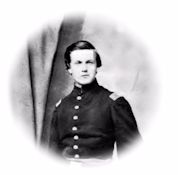Stoneman Station, Va.,
Tuesday, March 24, 1863.
Dear Brother and Sister:—
Well, now about those officers. “Commencing with the Corporal” Imprimis (seems to me that’s commencing at the little end of the horn, though): A Corporal (there are eight of them in a full company) occupies about as responsible a position as a printer’s devil. As “Corporal of the Guard” it is his duty to post and relieve the guards and keep an open ear for the call of the sentry, “korboral of de gart, last number”—when that individual may have discovered a “mare’s nest” or wants to be relieved to attend to his Virginia quickstep. He is considered of little account, and his privileges are immunity from standing guard and all fatigue duty. He is distinguished by two stripes on the sleeve
The Sergeants come next (in your order), five in number. The fifth or lowest in rank is the Commissary Sergeant. He draws and distributes the company’s rations. The Fourth Sergeant superintends the details of guards and fatigue parties. The Third Sergeant and the Second in turn act as “Sergeants of the Guard.” As such his duty is to keep the names of the daily guards, form all reliefs and turn them over to the Corporal, turn out the guard on the approach of an officer entitled to the compliment. The First, or Orderly Sergeant, is the most important of any of the non-commissioned officers. He has more to do than any other officer in the regiment, except perhaps the Adjutant. He calls every roll, always forms the company, makes the reports, and does all the business of the company. His pay is $20, other Sergeants $17 per month. They are distinguished by three stripes on the sleeves, and the Orderly by the addition of a diamond. These marks are called chevrons. Of the commissioned officers I need sav but little. The Captain’s duty is to command the company. You know what that is well enough. The First Lieutenant takes command in the absence of the Captain, and the next the Second Lieutenant. These officers are distinguished by their shoulder straps. A Captain’s has two bars at each end. A First Lieutenant’s has one bar at each end, and a Second Lieutenant’s plain strap without bars. A Major has a gilt leaf on each end of his straps, a Lieutenant Colonel silver leaves. A Colonel has a silver eagle in the middle of each strap. Now, could you tell a man’s rank by his marks? If we go further up, I might say that a Brigadier General is distinguished by a silver star in the place of the eagle, and a Major General by two stars. Officers are also distinguished by the buttons on their coats. A line or company officer and a staff officer (Adjutants, Surgeons, Chaplains and Quartermasters) wear only a single-breasted coat. A field officer (Colonel, Lieutenant Colonel and Major) wears two rows of buttons at regular spaces. A Brigadier General wears three in a group, and a Major General two.
The meeting of the debating club last night was a feast for a hungry mind. The scene reminded me much of some exhibition at home. The building is a log one covered with canvas, and the seats mere logs, but a big fire was blazing in the fireplace, and the room was warm and comfortable. It was decorated with pendant wreaths and loops of evergreen, and two tasty chandeliers lit up the hall cheerfully. It was filled with well dressed, gentlemanly soldiers, and the exercises, a paper, a poem, and a debate, were so interesting I had hard work to tear myself away before it broke up, but duty first and pleasure afterwards is military style.



